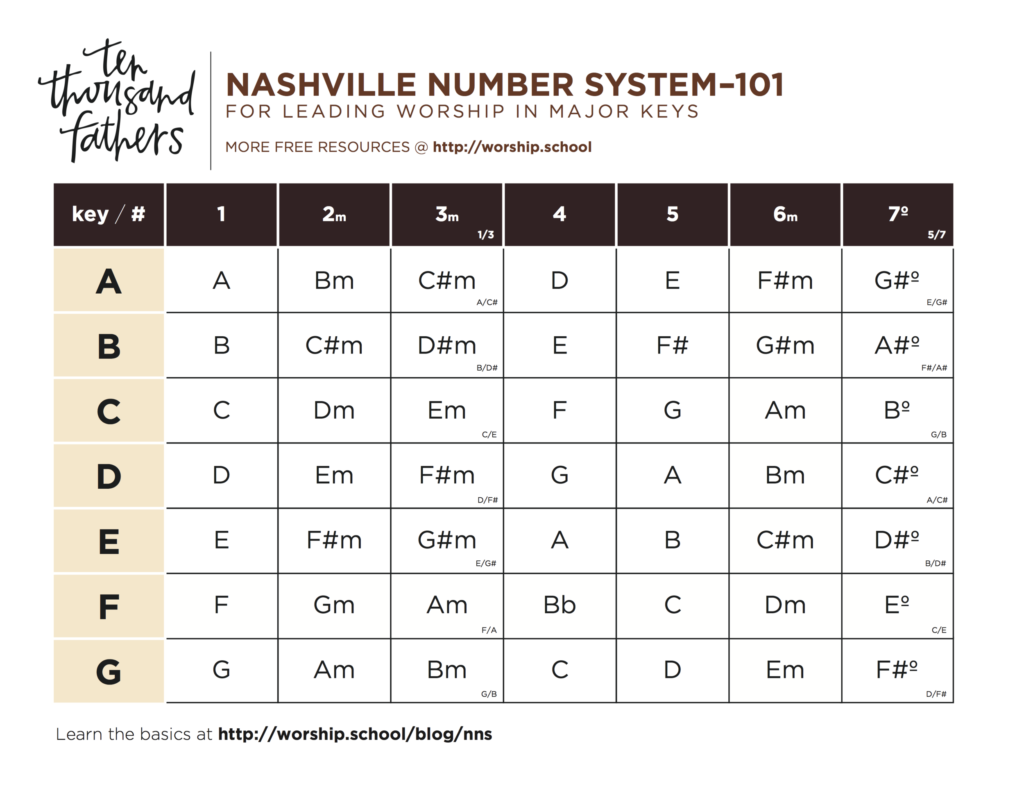
Nashville Number System: 101–Worship Leading
We’ve all been there…
We posted the song on Planning Center in the key of F, (and everyone learned it in F), then on Sunday morning the vocalist can’t hit the high-note. She needs it dropped to the key of E… Or, in the middle of rehearsal, you realize it’d be great to flow from one song into the next, but you learned one in the key of B and the other is the key of C. Do you need to run back into the church office and print out new chord charts for the band?
The Nashville Number System (NNS) will soon become your best friend. NNS is a method of transcribing music by denoting the scale degree on which a chord is built. It was developed by Neal Matthews, Jr. in the late 1950s, and it’s become the standard in many of the churches in America.
How does it work?
Instead of using chords (like “G, D, Em, C”), the NNS uses numbers, and the numbers represent scale degrees. For example, in the key of C, it would be: C=1, Dm=2, Em=3, F=4, G=5, Am=6, G#º=7, C=1. The chart below makes this clear for each of the keys:

A few helpful notes:
- Most worship songs are in Major keys. Since this is NNS–101, the chart above is for Major keys (and doesn’t show the half-steps between A,B,C,D,E,F,G). As you learn NNS, you’ll be able to “read between the lines” of this chart and apply it to any Major key.
- In Major scales:
- The 2, 3, 6 scale degrees are always minor.
- The 1, 4, 5 are always major.
- The 7s are technically diminished chords, but typically played as 5/7 in contemporary worship music. (Note the 5/7 chords shown in the bottom corners.) The same is true for 3s… Lots of time they’re played as 1/3 in worship songs, as transition chords. Always check with your band to decide which choice is right for the song.
How to begin learning the chart on your instrument:
- Guitarists, start with the key of G. Pianists, start with the key of C.
- These chords are likely very familiar to you. Take note of the connection between each chord and number. (Remember: 1,4,5 are major, 2,3,6 are minor, and 3s and 7s are typically transition chords)
- Pick a familiar song, How Great is Our God (Key of G)/(Key of C) and transpose it from chords to numbers.
- After you become comfortable with this first key, jump to another.
- Guitarists, if you learn the numbers for the key of G and the key of C, you unlock every key if you play with a capo.
- All keys from G — B can be played with a capo in the G formation.
- All keys from C — F# can be played with a capo in the C formation.
As you begin getting comfortable with numbers, pick a time to email your team and share that you want to begin introducing NNS in the team. (Send them to this article: http://worship.school/blog/nns)
The next Sunday, pick a staple song from your repertoire and use numbers instead of chords. Don’t go 100% NNS from the start, people will be overwhelmed and/or discouraged. Slowly integrate it and your team will learn with you. Here’s a sample number chart for our song, Lion of Judah (#).
Finally, we should remember that as we grow in these small competencies, we’re obeying Psalm 33’s call for us to “play skillfully.”
Can we get by with chord charts for the rest of our lives? Sure… But if you ever get tapped to hop on stage with professional musicians, you’ll be darn glad you learned your numbers 🙂